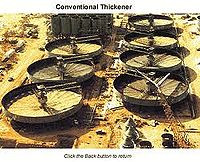Thickeners
Thickeners are used in separation of solids from a liquid by gravity sedimentation has traces to the early days of civilization. The normal practice at those times was to use jars or pits mainly for the clarification of extracted liquids such as wine or olive oil from contaminating insoluble matter. These batch processes required four separate steps:
Filling the vessel with slurry.
Leaving the slurry for a predetermined time until the solid matter has settled to the bottom of the vessel.
Decanting the clarified supernatant from the upper part of the vessel.
Removing the settled underflow that has accumulated at the bottom of the vessel.
This cycle, depending on solid and liquid properties that effect settling rate, may require long detention times so often several vessels are incorporated in the layout to operate in sequential steps.
The method of operating on a batch process is still practiced in small flow industries but its shortcomings are obvious so once the plants grew larger the need for continuous operation became inevitable. The trend in this direction started at the late 19th century when heavy duty applications such as iron ore taconites, hematite, coal, aluminum hydrate, copper pyrite, phosphates and other beneficiation processes have grown rapidly. The high time for thickeners was in the 60's when the metallurgical industries were booming and sizes of up to 150 m diameter were constructed. Such jumbo thickeners, when centrally driven, require for most demanding applications extra heavy duty drive heads some of which reach a continuous operating torque of 3.300.000 Nm.
Features
- They occupy large spaces as may be seen from the aerial photograph of three large thickeners.
- They are normally positioned far away from the center of the plant and owing to the large flows they are fed by gravity to save pumping. Therefore their position for a given hydraulic gradient may determine the elevation of the entire plant.
- Rake driven thickeners for continuous operation can impose a substantial burden on capital investment.
- Unlike many other types of equipment, thickeners have no stand-bys so if one goes out of commission it cannot be by-passed. Consequently, if this happens other thickeners have to take the extra load but if the plant incorporates just one thickener then the entire production line must stop.
- To take a thickener out of commission for repairs inside the tank such as damaged blades, or rubber lining may take days since it requires to empty the tank, remove the underflow bed, refill it and find a suitable storage or disposal site for very large volumes of liquid.
Video
—
